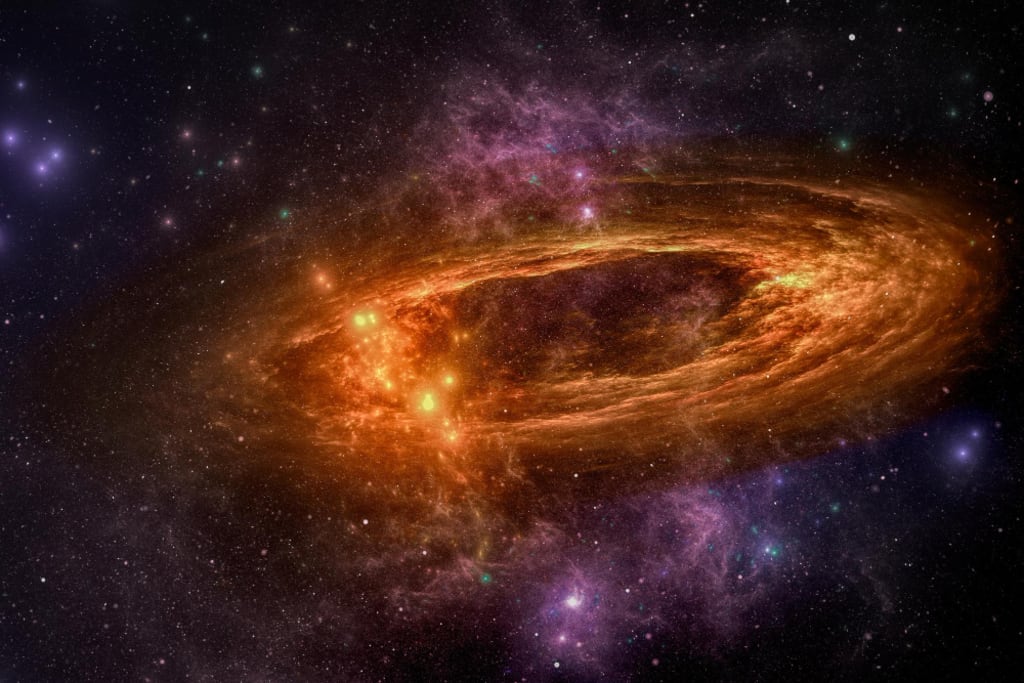"Exploring the Wonders of the Milky Way: A Journey Through Our Galaxy"
"Discovering the Beauty and Mystery of the Milky Way"

As we look up at the night sky, one of the most striking sights is the band of light that stretches across the sky, known as the Milky Way. This is the galaxy in which we live, and it is truly a marvel of the universe.
The Milky Way is a spiral galaxy, which means that it has a flat disk-like structure with spiral arms that contain stars, gas, and dust. It is estimated to be around 100,000 light-years in diameter and to contain around 100 billion stars. Our Sun is located on the Orion Arm, about 25,000 light-years from the center of the galaxy.
One of the most interesting features of the Milky Way is the presence of a supermassive black hole at its center. This black hole is thought to have a mass of around 4 million times that of our Sun and is surrounded by a swirling disk of gas and dust. The study of this supermassive black hole and its surrounding area is known as galactic center research, and it is a fascinating field that continues to expand as new technologies and techniques are developed.
The Milky Way is also home to a variety of different types of stars, including red giants, blue giants, and white dwarfs. The most common type of star in the galaxy is the red dwarf, which makes up around 75% of the total number of stars.
One of the most fascinating aspects of the Milky Way is the presence of a number of different nebulae. These are vast clouds of gas and dust that are lit up by the intense radiation from nearby stars. The most famous of these is the Orion Nebula, which is located in the constellation of Orion and is one of the brightest and most easily visible nebulae in the night sky.
In addition to the stars and nebulae, the Milky Way also contains a number of different types of celestial objects. These include planets, comets, asteroids, and even a few rogue planets that are not associated with any particular star.
The study of the Milky Way and other galaxies is known as galactic astronomy, and it is a field that is continually expanding as new technologies and techniques are developed. With the help of telescopes such as the James Webb Space Telescope, scientists will be able to study the galaxy in more detail than ever before, and uncover more of its mysteries.

A nebula is a cloud of gas and dust in space. They come in a variety of shapes and sizes and can be found in many different locations in the galaxy, including the spaces between stars, around stars, and in the centers of galaxies. Some nebulae are formed by the collapse of gas and dust under the influence of gravity, which can lead to the formation of new stars. Other nebulae are created by the explosive death of stars, such as supernovae. The most famous example of nebulae is the Orion Nebula, which is visible to the naked eye and is one of the most studied nebulae in the sky. The colors of nebulae are caused by the different types of gases and dust present in them, and the way that they are lit by the stars nearby.

A black hole is a region of space with a gravitational pull so strong that nothing, not even light, can escape from it. They are formed when massive stars die and their cores collapse under the force of gravity. The boundary around a black hole beyond which nothing can escape is called the event horizon. Black holes are invisible, as they do not emit any light, but their presence can be inferred by observing the effects of their gravity on nearby matter, such as stars and gas. They can also be detected by their intense gravity, which bends and distorts light from objects behind them, an effect known as gravitational lensing. There are several types of black hole, including stellar black holes, intermediate black holes, and supermassive black holes, which are believed to exist at the center of most galaxies, including our own Milky Way galaxy.
In conclusion, the Milky Way is a truly fascinating and mysterious place, full of stars, nebulae, black holes and other celestial objects. It is a reminder of how small and insignificant we are in the grand scheme of the universe, but at the same time, it is a source of wonder and inspiration that can remind us of the beauty and majesty of the cosmos. So next time you look up at the night sky, take a moment to appreciate the wonder of our galaxy, the Milky Way, and the endless possibilities that it holds.
About the Creator
Muthumariselvam mariyappan
As a dedicated and experienced article writer, I have a passion for crafting compelling stories and delivering informative content on a wide range of topics.





Comments
There are no comments for this story
Be the first to respond and start the conversation.